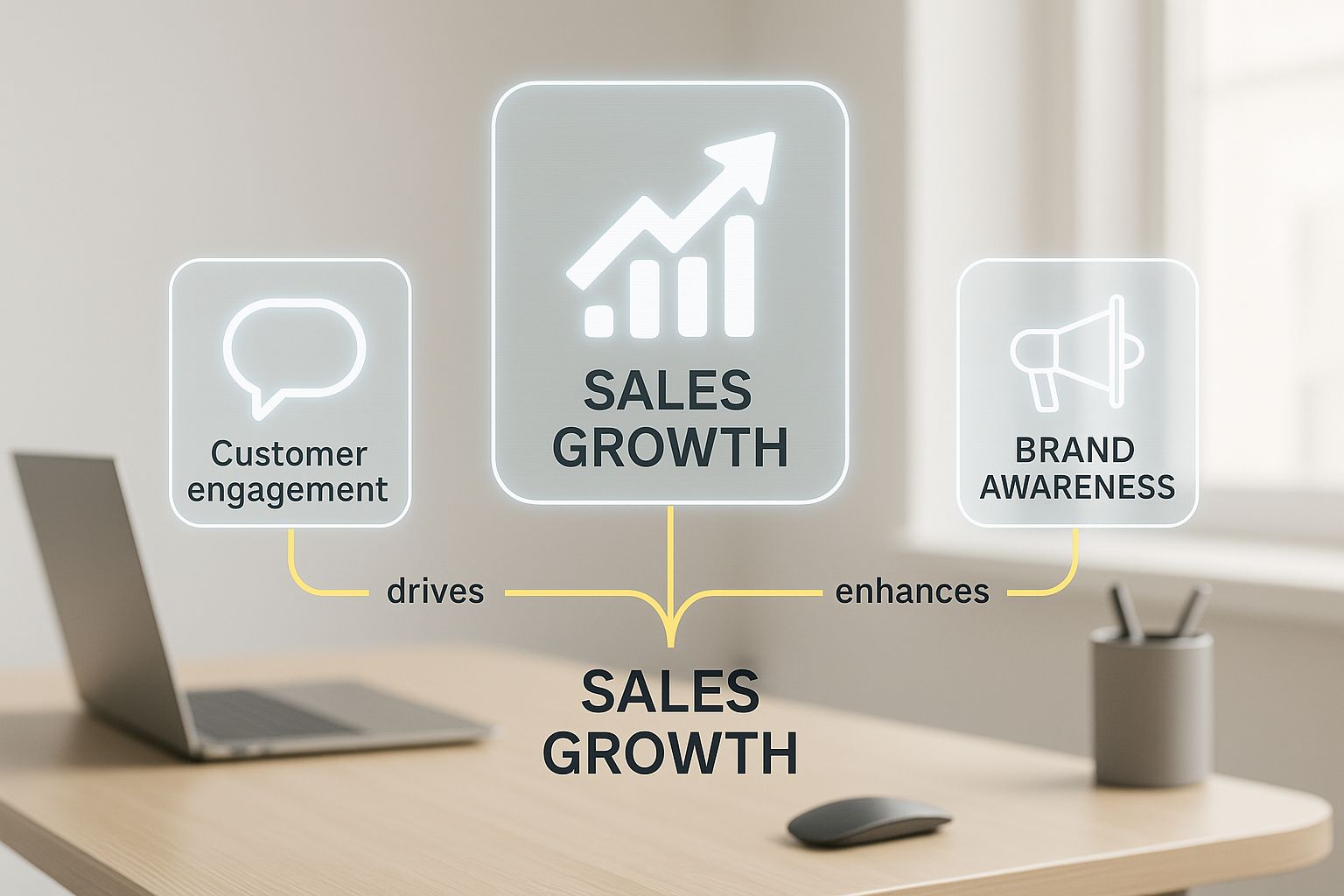At its core, the meaning of an outbound call is pretty simple: it's any phone call a business starts with a customer or potential client. This proactive approach completely flips the script on the old way of doing things, where you just sit back and wait for the phone to ring.
What Outbound Calls Really Mean Today

Let's ditch the outdated picture of a pushy salesperson making annoying cold calls. These days, outbound calling is all about smart, strategic communication that actually adds value. It’s your business starting a conversation, not just to close a deal, but to build a genuine connection. This shift is a game-changer for Aussie businesses wanting to connect with customers on their own terms.
Think of it like this: having a shop with an "Open" sign is your inbound strategy. But having a friendly team member step outside to greet passersby and see if they need a hand? That's outbound. This kind of proactive engagement can show up in many ways, all designed to build lasting loyalty and help your business grow.
Modern Applications of Outbound Calls
Instead of being purely about sales, today's outbound strategies have a much wider scope:
- Proactive Customer Service: This could be anything from a quick call to remind someone of their appointment, let them know about a service update, or a follow-up after a purchase just to make sure they're happy.
- Lead Nurturing: A well-timed call can turn someone who just browsed your website into a genuine lead by offering them personalised info or a quick demo.
- Relationship Management: Checking in with your best clients to offer support or ask for feedback shows you care about their business long after the first sale.
To really get your head around proactive customer engagement, it’s worth digging into the full definition and mechanics of What is Outbound Sales.
An outbound call gives you the chance to control the conversation. Instead of waiting for problems or questions to pop up, you get to create positive moments that strengthen the customer relationship and guide them along their journey with your brand.
Outbound Vs Inbound Calls
Ever wonder about the real difference between an outbound and an inbound call? Think of it like fishing.
An outbound call is like casting a line out into the water—you’re actively reaching out, hoping to get a bite. You’re initiating the conversation, whether it’s to follow up on a lead, check in with a customer, or share some new information.
On the flip side, an inbound call is when a fish jumps right into your boat. The customer is the one making the first move, calling you because they need help, want to buy something, or have a question. You’re reacting to their needs.
This simple distinction—who starts the conversation—is at the heart of the fundamental shift in initiative between inbound and outbound strategies.

While both are just phone calls, they serve completely different purposes and require totally different mindsets. Getting a handle on these differences is key to building a communication strategy that actually works.
For a deeper dive into how these two call types can work together for your business, check out our detailed comparison here: https://onsilent.com/non-classe/inbound-vs-outbound-calls/
Let’s break down the key differences to make it crystal clear.
| Attribute | Outbound Calls (Proactive Outreach) | Inbound Calls (Reactive Response) |
|---|---|---|
| Initiator | Your business or agent initiates the call. | The customer or prospect initiates the call. |
| Primary Goal | Generating leads, sales, follow-ups, or conducting surveys. | Addressing customer service issues, providing support, or processing sales. |
| Mindset | Proactive, strategic, and often persuasive. | Reactive, helpful, and focused on problem-solving. |
| Success Metric | Conversion rates, appointments set, successful lead qualifications. | First-call resolution, customer satisfaction scores (CSAT), low wait times. |
As you can see, outbound calling is all about driving the action, while inbound is about skillfully managing the interest that comes your way. One isn’t better than the other; they’re two sides of the same coin, both vital for growing and maintaining a healthy business.
How Businesses Use Outbound Calls to Grow

Knowing the theory behind outbound calls is one thing, but seeing it in action is where you really see the magic happen. Forward-thinking Australian businesses are using proactive calling for a lot more than just old-school sales pitches. They're using it as a clever tool to build relationships, head off problems before they start, and sniff out new opportunities.
This whole proactive approach is a massive shift away from just sitting back and waiting for customers to get in touch. It’s about grabbing the bull by the horns to create positive interactions that deliver real, tangible results across the entire business.
Proactive Customer Service and Support
One of the most powerful ways to use outbound calls is in customer service. Instead of waiting for a client to ring up with a complaint, smart businesses are making the first move to make sure everything runs smoothly.
This isn't rocket science. It's about practical, helpful calls like:
- Appointment Confirmations: A quick call to confirm a meeting or service appointment. It slashes no-shows and just looks professional.
- Service Updates: Letting a customer know about a delivery delay or scheduled maintenance ahead of time. It stops frustration in its tracks and manages expectations.
- Post-Purchase Check-ins: A follow-up call after a sale to see if the customer is happy with their purchase. This builds a huge amount of goodwill.
When you reach out first, you flip customer service on its head. It goes from being a reactive cost centre to a proactive engine for building loyalty. This simple gesture can make a massive difference to customer satisfaction and retention.
Lead Nurturing and Qualification
Outbound calls are also your secret weapon for turning a bit of curiosity into a genuine sales opportunity. When someone downloads a guide from your website or fills out an enquiry form, they've raised their hand. A timely, helpful follow-up call can be the very thing that nudges them over the line.
This isn't about the hard sell. It's about getting to know their needs, answering their questions, and pointing them toward the right solution. That personal touch is often what separates a warm lead from a done deal.
By managing these follow-ups properly, you make sure no potential opportunity slips through the cracks. For busy professionals juggling these tasks, looking into a solid call management software can be a total game-changer.
Market Research and Client Relationships
Finally, outbound calls give you a direct line to your market for feedback you just can't get anywhere else. A short, well-planned call can uncover insights that online surveys completely miss, helping you tweak your products or services to better fit what people actually want.
On top of that, a quick, personalised check-in call with your high-value clients really strengthens those crucial relationships. It shows you value them as a partner, not just a number on a spreadsheet. This fosters serious loyalty and opens the door for more business down the track.
The True Business Impact of a Proactive Call Strategy
Jumping on a proactive outbound strategy is about more than just dialling numbers; it's about making genuine connections that deliver real, measurable results for your business. A well-thought-out outbound call is a powerful way to build serious customer loyalty. When you reach out first, you're sending a clear message: you value their business beyond just a single sale. That’s how you turn a simple transaction into a lasting relationship.
This proactive approach also means you're in the driver's seat of your sales pipeline. Instead of just waiting around for leads to maybe come your way, your team is out there actively finding, engaging, and qualifying potential customers. This direct method doesn't just fill your pipeline; it also helps shorten the sales cycle by quickly sorting the hot prospects from the time-wasters.
Shaping Your Brand and Gathering Insights
Every single outbound call is an opportunity to tell your brand's story. In a real conversation, you can get across your company's values and commitment to customer success in a way that a digital ad or an email just can't. That personal touch is what builds stronger, more profitable relationships down the track.
Plus, these calls are a direct line to what your market is actually thinking. You get raw, unfiltered feedback straight from the source—what your customers love, their biggest headaches, and what they really need. This kind of intel is absolute gold for your product development and marketing teams, letting you pivot and adapt much faster than competitors who are just guessing based on surveys. The advantages of good call handling really shine through when you see how it shapes perception and gathers priceless data.
A proactive call strategy shifts your business from being a passive bystander to an active player in your customer's journey. It’s all about creating opportunities, not just waiting for them to knock.
The Financial Footprint of Proactive Outreach
The value of getting on the front foot with communication is clearly reflected in market trends. The Australian outbound telemarketing market alone is valued at around USD 143.83 million. That's a massive figure, and it shows just how many businesses are relying on outbound strategies to fuel their growth and stay ahead of the pack. You can dig into more insights about this growing market and its regional trends to really grasp its full potential.
The Real-World Hurdles of Modern Outbound Calling
Look, a proactive outbound strategy can be a game-changer, but it’s not always a walk in the park. To get it right, you need to understand the real-world obstacles that can trip you up, even when you have the best intentions. From keeping your team fired up to staying on the right side of the law, a smart approach is non-negotiable.
One of the biggest headaches in any call centre is agent burnout and the revolving door of staff turnover. When your team is smashing out dozens of calls every single day, the grind can lead to exhaustion and a total lack of engagement. This isn't just a morale problem; it's a massive hit to your bottom line.
Just to give you an idea, the average attrition rate across Australian contact centres recently hit a staggering 29%. And for the bigger players? It was as high as 43.4%. To stop the bleed, you’ve got to invest in proper training, have supportive managers, and set realistic goals that actually keep people motivated.
Shaking Off the 'Cold Call' Stigma
Let's be honest, the term "cold calling" has a bad rap. The second you mention it, you can almost feel potential customers putting their walls up. The secret? Stop making cold calls. Seriously. Start making warm, informed ones instead.
It’s all about a simple shift in how you approach it:
- Do Your Homework: Before you even think about dialling, spend five minutes researching the person or their business. A quick look at their industry or recent company news gives you a personalised opener that shows you’ve actually made an effort.
- Lead with Value, Not a Pitch: Instead of launching into a sales pitch, open with a useful insight, a relevant stat, or a helpful observation. You want to be seen as a resource, not just another salesperson.
- Make it About Them: Frame the entire conversation around their potential problems and goals. Ask smart questions to figure out what they need long before you even whisper a word about your solution.
When you turn your outreach from an unwelcome interruption into a helpful conversation, you change the entire dynamic. A well-researched, value-first call isn't "cold" anymore—it's a professional consultation.
Staying Compliant and Working Smarter
Finally, you absolutely cannot ignore the legal stuff, like Australia's Do Not Call Register. Keeping your lists clean and your practices compliant protects your reputation and saves you from some seriously hefty fines. But beyond just ticking the boxes, you need to be efficient. For any business tired of the old-school manual grind, exploring auto lead generation strategies can open your eyes to a whole new way of working. By blending ethical practices with smart tools, you’re not just making calls—you’re building a sustainable and powerful outbound engine.
Still Got Questions About Outbound Calls?
Even after getting the hang of outbound calling, a few common questions tend to pop up. Let's get those sorted so you can feel completely confident about your communication strategy.
Think of this as moving from theory to real-world action. Getting these last few details ironed out will help you put a successful outbound plan into practice.
Is Cold Calling the Same as Outbound Calling?
Not even close. It's a common mix-up, but thinking all outbound calls are cold calls is like saying all driving is Formula 1 racing. Sure, cold calling is one type of outbound call, but it's just a tiny piece of the puzzle.
The term outbound calls is much broader, covering any call your business makes. This includes a whole range of valuable conversations that have nothing to do with calling someone out of the blue.
- Warm Calls: You’re reaching out to people who’ve already shown interest, maybe by downloading something from your site or filling out a form. They know who you are.
- Customer Service Follow-ups: This is all about being proactive. You might call a customer after a purchase just to make sure they’re happy and everything is working as it should.
- Appointment Reminders: A quick, helpful call to confirm a meeting or service. It's a simple touch that drastically reduces no-shows and shows you value their time.
Modern, effective strategies focus on these value-driven conversations. They’re far more successful and better received than just dialling for dollars.
What Are the Key Metrics for a Successful Outbound Call?
There’s no one-size-fits-all answer here. Success depends entirely on why you made the call in the first place. You wouldn't measure a customer support check-in with the same yardstick as a sales pitch.
The most important metric is dead simple: did the call achieve its purpose? A smart outbound strategy is always goal-oriented, focusing on real results, not just how many numbers you’ve dialled.
For instance, if you're trying to generate leads, you’d track the number of qualified leads generated or appointments set. But for a proactive customer service call, you might look at the customer satisfaction score (CSAT). Other solid metrics to keep an eye on are the connection rate (how many people actually pick up) and the conversion rate (how many calls hit their specific goal).
How Is Technology Improving Outbound Calling?
Technology has completely flipped the script, making outbound calls smarter, more efficient, and way more personal. The right tools let your team focus on what they do best: having great conversations.
AI-powered predictive diallers, for example, are a game-changer. They automatically filter out busy signals, disconnected numbers, and voicemails, so your team only talks to real people. Deep CRM integrations are also a must-have, putting a customer’s entire history right at your fingertips. This lets you have relevant, helpful chats that don’t feel like an interruption. Some tech can even analyse calls to figure out what language and tone works best, giving you powerful coaching insights to level up your team’s performance.
Stop missing important calls and start managing your communications more effectively. OnSilent organises your calls and messages, so you can focus on growing your business. Discover how at https://onsilent.com.

